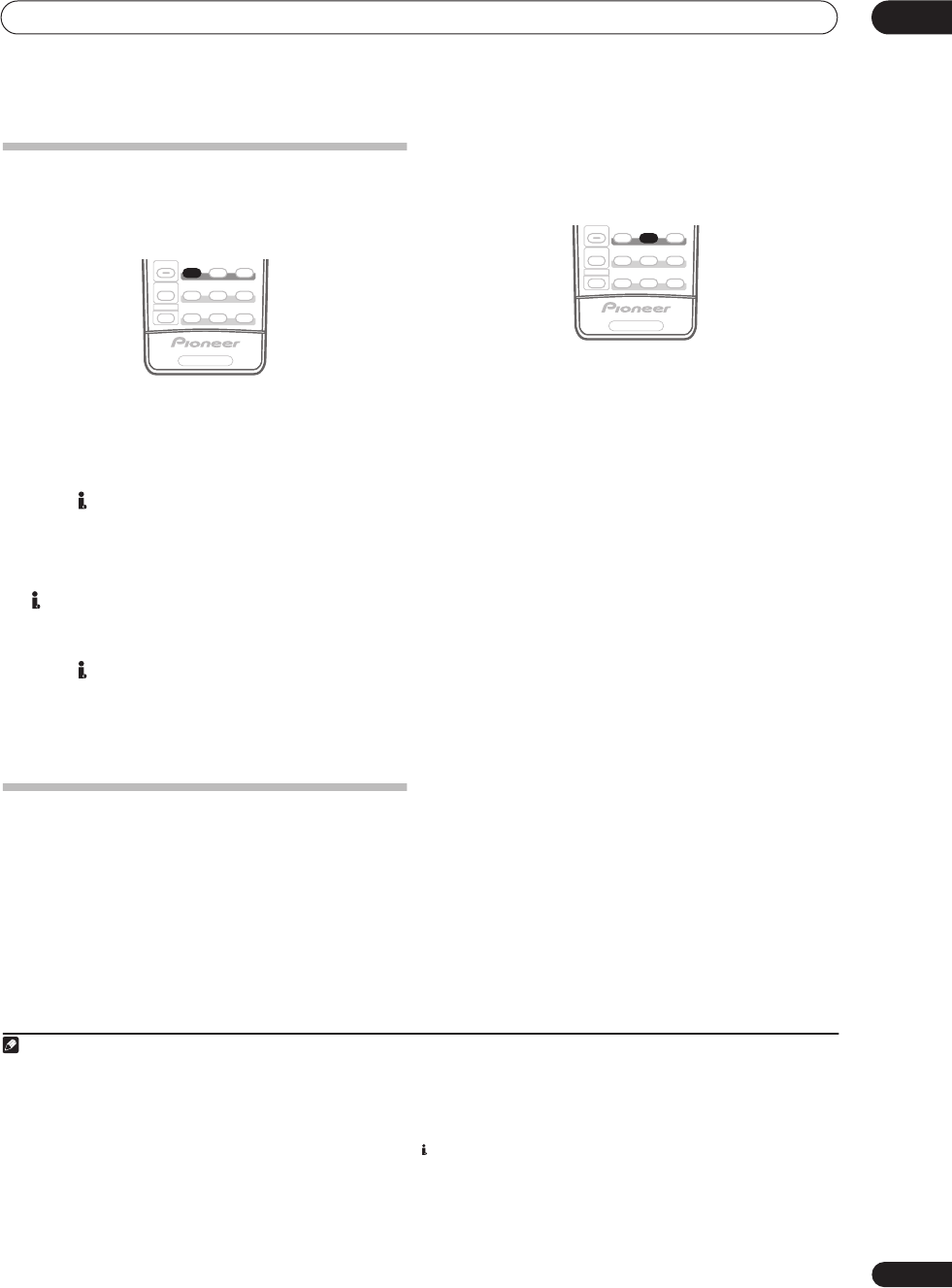
Listening to your system
05
31
En
Choosing the input signal
You need to hook up a component to both analog and
digital inputs on the receiver to select between input
signals.
1
• Press
SIGNAL SEL (SIGNAL SELECT
) to select the
input signal corresponding to the source component.
Each press cycles through the options as follows:
•
AUTO
– This is the default setting. The receiver
selects the first available signal in the following
order: ;
HDMI
;
DIGITAL
;
ANALOG
.
•
ANALOG
– Selects an analog signal.
•
DIGITAL
– Selects an optical or coaxial digital signal.
•
HDMI
– Selects an HDMI signal.
2
• – Selects an i.LINK signal (VSX-AX4ASi only).
•
PCM
– Only PCM signals are output.
3
The receiver
selects the first available signal in the following
order: ;
HDMI
;
DIGITAL
.
When set to
DIGITAL
or
AUTO
,
2
DIGITAL
lights with
Dolby Digital decoding,
DTS
lights with DTS decoding,
and
WMA9 Pro
lights to indicate decoding of a WMA9
Pro signal.
Using surround back channel processing
• Default setting:
SBch ON
You can have the receiver automatically use 6.1 or 7.1
decoding for 6.1 encoded sources (for example, Dolby
Digital EX or DTS-ES), or you can choose to always use
6.1 or 7.1 decoding (for example, with 5.1 encoded
material). With 5.1 encoded sources, a surround back
channel will be generated, but the material may sound
better in the 5.1 format for which it was originally
encoded (in which case, you can simply switch surround
back channel processing off).
The table below indicates when you will hear the
surround back channel when playing various kinds of
sources. (
ì
=Sound plays through surround back
speaker(s))
• Press
SBch
(SBch PROCESSING) repeatedly to cycle
the surround back channel options.
Each press cycles through the options as follows:
•
SBch ON
– 6.1 or 7.1 decoding is always used (for
example, a surround back channel will be generated
for 5.1 encoded material)
•
SBch AUTO
– Automatically switches to 6.1 or 7.1
decoding for 6.1 encoded sources (for example,
Dolby Digital EX or DTS-ES)
•
SBch OFF
– Maximum 5.1 playback
Using the Virtual Surround Back mode
When you’re not using surround back speakers,
selecting this mode allows you to hear a virtual surround
back channel through your surround speakers. You can
choose to listen to sources with no surround back
channel information, or if the material sounds better in
the format (for example, 5.1) for which it was originally
encoded, you can have the receiver only apply this effect
to 6.1 encoded sources like Dolby Digital EX or DTS-ES.
4
The table indicates when you will hear the virtual
surround back channel. (
ì
=Virtual surround back
channel is active)
• Press
SBch
(SBch PROCESSING) repeatedly to cycle
the virtual surround back channel options.
Each press cycles through the options as follows:
•
VirtualSB ON
– Virtual Surround Back is always used
(for example, on 5.1 encoded material)
•
VirtualSB AUTO
– Virtual Surround Back is
automatically applied to 6.1 encoded sources (for
example, Dolby Digital EX or DTS-ES)
Note
1• This receiver can only play back Dolby Digital, PCM (32 kHz to 96 kHz), DTS (including DTS 96 kHz/24 bit) and WMA9 Pro digital signal formats. With
other digital signal formats, set to
ANALOG
(the
MULTI CH IN
,
TUNER
,
PHONO
and
iPod
input functions are all fixed to
ANALOG
).
• You may get digital noise when a LD or CD player compatible with DTS is playing an analog signal. To prevent noise, make the proper digital connec-
tions (page 15) and set the signal input to
DIGITAL
.
• Some DVD players don’t output DTS signals. For more details, refer to the instruction manual supplied with your DVD player.
• Even when i.LINK is selected and the i.LINK indicator lights, you won’t hear any sound if the output settings of your i.LINK device are off.
• The input signal for unassigned i.LINK-equipped components is fixed to . See
Checking the i.LINK inputs
on page 52.
2 When the
HDMI
option in
Setting the AV options
on page 66 is set to
THROUGH
, the sound will be heard through your TV, not from this receiver.
3• This is useful if you find there is a slight delay before
AUTO
recognizes the PCM signal on a CD, for instance.
• When
PCM
is selected, noise may be output during playback of non-PCM sources. Please select another input signal if this is a problem.
SHIFT
STATUS
MCACC S.DIRECT
MULTI OPE
SIGNAL SEL
SBch
STEREO
ADV. SURR
STANDARD
PHASE
THX
RECEIVER
4• You can’t use the Virtual Surround Back mode with headphones, or with the
THX
,
STEREO
or Stream Direct modes.
• You can only use the Virtual Surround Back mode if the surround speakers are on and the
Surr Back
setting is set to
NO
in the
Speaker Setting
on
page 45.
• The Virtual Surround Back mode cannot be applied to sources that do not have surround channel information.
SHIFT
STATUS
MCACC S.DIRECT
MULTI OPE
SIGNAL SEL
SBch
STEREO
ADV. SURR
STANDARD
PHASE
THX
RECEIVER
VSX_AX4ASi.book.fm 31 ページ 2006年6月8日 木曜日 午後12時23分


















